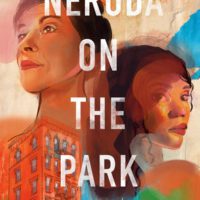New York City’s neighborhoods are constantly shifting and evolving, as immigrant communities find refuge, new generations build families, people move here or move away, and areas are re-zoned. The rolling wave of NYC’s gentrification comes swiftly, mercilessly, ebbing and flowing beyond our control. People throw up their hands, powerless: What can you do?
In Neruda on the Park, a mother and a daughter respond to the gentrification of their NYC neighborhood in two utterly divergent ways. Aging matriarch Eusebia tries to fight the encroaching corporate developers, enlisting the help of neighbors and friends to try to discourage them with acts of crime and chaos, while her cosmopolitan daughter Luz, a high-powered lawyer, is seduced by the glamour of the so-called enemy. But that’s just the tip of the iceberg.
The fictive neighborhood surrounding Nothar Park is home to a vibrant Dominican community of all ages and walks of life. Some are chasing a past or a future back home in the Dominican Republic, while others seek to rise above their modest means through higher education. Nothar Park feels like it could easily be an enclave in the Bronx, Washington Heights, Inwood, or Harlem; in Cleyvis Natera’s lyrical rendering, the park neighborhood takes on a mythical quality. Through the eyes of Eusebia, Luz, and a chorus of gossipy neighborhood women dubbed “The Tongues,” we learn about how the changes threatening an immigrant community’s soul are metabolized by the elders who cling to tradition and by the next generation forging their own paths—paths that may even aid in the destruction of their childhood homes.
Luz is a Harvard-educated lawyer with a fancy wardrobe and sky-high ambition, and she already feels the resentment of her neighbors when she returns home to her parents’ apartment every night, where she lives ostensibly to save money for her future escape. Unlike her mother, Luz seems resigned to gentrification, accepting its grip on her home. She dreams instead of acquiring a fancy Central Park West apartment, where, she imagines, she can fully ensconce herself in the glamorous and whitewashed society of her professional life:
Luz knew the truth about the way a city responds to a community of folks who may not even be eligible to vote, who didn’t have the know-how to demand change, even of the smallest kind . . . She didn’t feel like she belonged here. There was hostility toward her, in the neighborhood, and she’d often felt like an outsider, especially when she went off to college. It only got worse after she graduated from law school. Luz already knew how this story ended—the neon-colored storefronts that lined their side of the park with their loud-ass blinking lights would transform as if by magic—cue in yoga, juice bars, endless mimosa brunch places with lines out the door.
Yet she has such fondness and gratitude for her parents—and for her father Vladimir’s dream of their future return to the Dominican Republic—that she is secretly contributing much of her savings to her father to help build a dream house in the DR for his and Eusebia’s retirement. We also see Luz’s palpable love for the traditions and foods of her community. She relishes eating her mother’s pasteles; encourages the collegiate ambitions of her precocious young neighbor Christian; and reconciles with childhood friend Angélica, whose life took a distinctly different turn from hers after high school into motherhood, waitressing, and caring for extended family in Nothar Park. Ultimately, Luz’s relationships draw her back into caring about the future of the community that made her an American.
While Luz begins the novel feeling sanguine about her community’s transformation, Eusebia takes a more militant, resistant stance. Trying to scare the corporate developers into abandoning their plans to construct luxury condos on Nothar Park, she enlists the help of their neighbors to play into the developers’ worst fears and stereotypes: She stages escalating episodes of harassment, vandalism, theft, destruction, and violence, with each episode stoking her obsession in creating a spectacle of fear. However, her tactics bely her naiveté, both about the power and disinterest of real estate moguls and about the ability of her neighbors to successfully gain recompense for her destruction of their property and threats to their well-being. A dear friend even faces sudden deportation after Eusebia ropes her into her dangerous scheme.
Eusebia experiences her life as a layered collage of sensations mirrored through her memories of the past, condensing time and space into a fever dream. Especially in these moments, Natera’s lush prose evokes Gabriel Garcia Marquez’s Love in the Time of Cholera with the surreal tint of Paul Auster’s New York Trilogy. When Eusebia readies herself for Vladimir’s departure to the Dominican Republic to finalize construction on their retirement home—which she sees as a forced relocation away from Nothar Park—she jumps through decades of her life in a single instant:
She wouldn’t miss their past either, whatever young self she used to be, always with her head in the clouds—allowing herself to be so easily led down a road she’d rather not travel. She would be fortified by Vladimir’s and Luz’s absence. Already, it was as if her bones encased stronger bones, her skin covered steel . . . She felt a delicious row of goosebumps down her spine.
Beyond him, through the window, the wind rustled the leaves outside. She had a strange premonition then, that unless she acted fast, she would never see the trees outside change colors, bare their limbs as they reached outward, upward. It would be her clothes inside a suitcase, locked up.
While gentrification catalyzes Neruda on the Park’s inciting incident, the deeper story here is about families, the love between mothers and daughters, the generational divide between parents and children, and our attempts to find meaning and happiness. I was reminded of the mother-daughter relationship in the recent film Everything Everywhere All at Once, and while there is no kung fu (nor multiverses) in Neruda on the Park, it is no less enjoyable. I tore through the latter half of the book in a day of ferocious reading.
One lovely mother-daughter moment comes when Luz recalls a memory in the Dominican Republic when she was nine-years-old:
It was there, as they stared at the vastness of the ocean and sky, that Eusebia had held Luz’s hand—you have to be brave for both of us, she’d said. The breeze carried within it the soothing scent of salt. Luz felt fortified by the air and by her mother’s words when she spoke of what awaited them in that strange new land. Even if we don’t love it there, we’ll make a good life, she’d told her. Was her mother scared? Eusebia’s conviction that they’d be accomplices of sorts, choosing happiness no matter what, made Luz believe so.
It also made her see her mother more clearly and love her more fiercely than ever. She understood, even as a nine-year-old, how the power dynamic was changing between them. Her mother needed her to be the one to take sure steps into the unknown. Her mother’s need made her feel powerful, but her assurance made her feel safe, too. Especially knowing Eusebia would be a few steps behind her, a hand nudging softly any time Luz hesitated, redirecting if she took a misstep.
This is a love letter to strong mother-daughter relationships. Yet as Neruda on the Park barrels towards its shocking conclusion, this bond between Luz and Eusebia is tested, stretched to its breaking point, leaving us to wonder about the limits of our own values and what we would do to preserve what we love. This book is also about legacies, how we build futures that we can stand to live in, and what we do for our families out of love and obligation.
And what of Neruda? The poet and namesake of the book in its title is omnipresent, with multiple couples reading his love poems to one another in whispered tones. A much-loved book of Neruda poems is compared, tellingly, with its luxury counterpart, a sterile museum-quality vintage edition that is kept away from rough and loving hands alike. But I see Neruda’s influence most in the tone of the book. Along with his romantic love poems, Neruda was also known for taking ordinary objects like onions, tomatoes, and even socks, and elevating them to the realm of the transcendent. Here’s how he ends “Ode to the Onion”:
to me, onion, you are
more beautiful than a bird
of dazzling feathers
heavenly globe, platinum goblet
unmoving dance
of the snowy anemoneand the fragrance of the earth lives
in your crystalline nature.
In Natera’s masterful debut novel, a simple New York City park becomes the verdant heart of a mythic neighborhood, where fire escapes are like golden staircases and the community goodwill of friends and neighbors becomes a nurturing flame that sustains its members’ hearts and souls.




